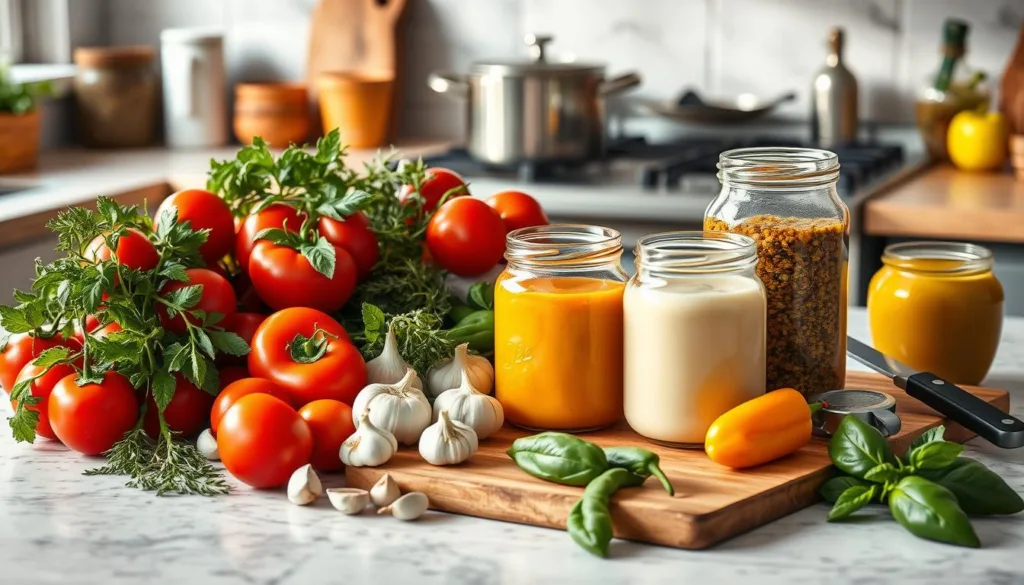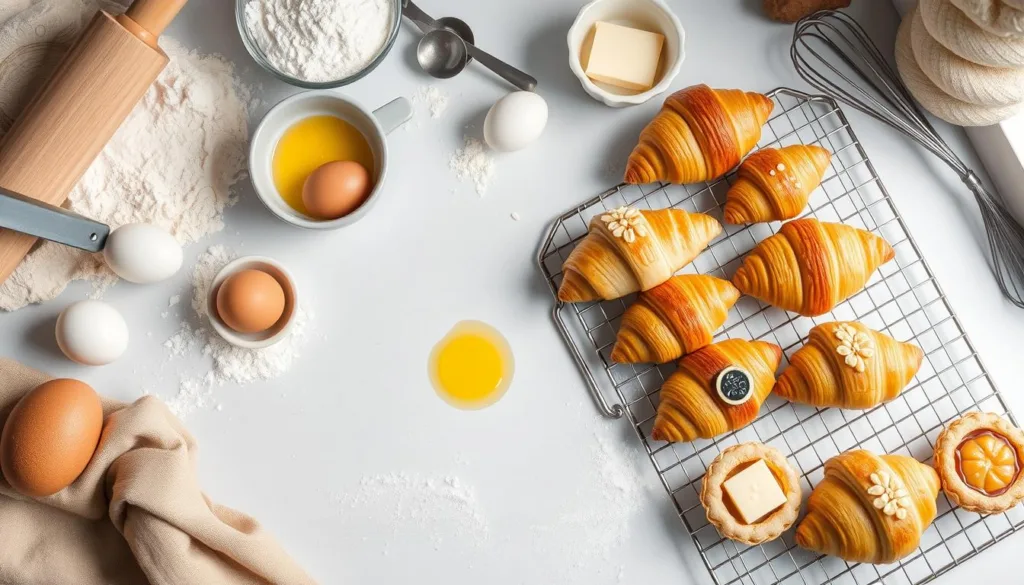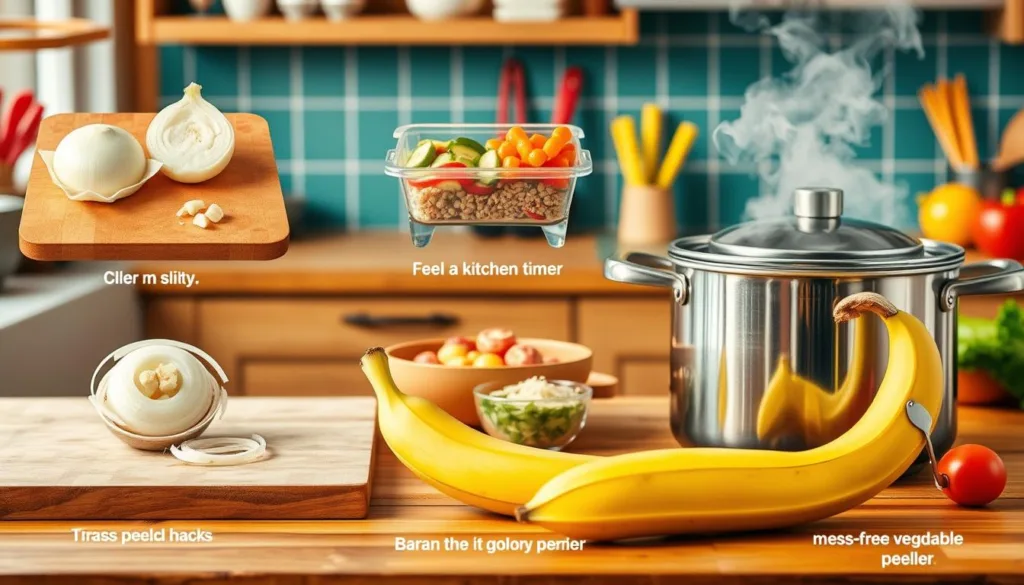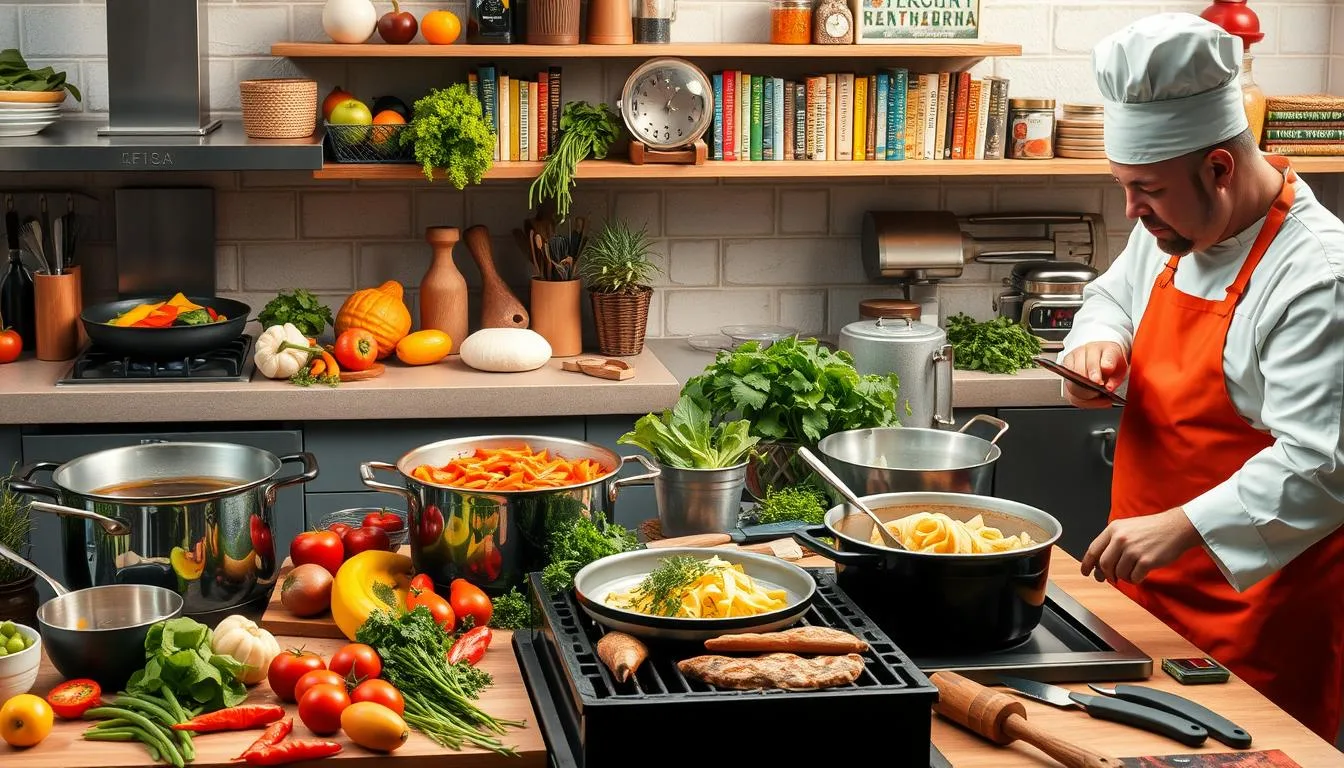Cooking is an art that turns simple ingredients into tasty meals. Learning 100 techniques can make you a culinary master. Professional chefs say knowing these skills boosts your kitchen confidence and meal quality.
Most home kitchens only have 10 of these techniques mastered. This means there’s a lot of room for improvement. By learning new skills, you can take your cooking from basic to amazing.
Starting your advanced cooking journey means learning the basics. This includes knife skills and temperature control. Each skill you learn gets you closer to making meals like a pro in your kitchen. Amazingly, 72% of home chefs believe mastering these techniques greatly improves their cooking.
This guide is for both beginners and experienced cooks. It will teach you key cooking techniques. You’ll learn to make simple ingredients into incredible dishes, save money on dining out, and wow your guests with your new skills.
Essential Kitchen Skills for Beginning Home Chefs
Starting your cooking journey means learning key kitchen basics. These skills turn new cooks into confident chefs. It’s not just about following recipes. It’s about enjoying and being efficient in the kitchen.
Good cooking begins with three main areas: knife skills, knowing your kitchen tools, and food safety. These tips will help you start strong in the kitchen.
Mastering Knife Skills and Cutting Techniques
Your knife is crucial in the kitchen. Learning to cut well makes cooking safer and faster. Here are some key skills:
- Holding a chef’s knife correctly
- Basic cutting methods: dicing, chopping, mincing
- Maintaining sharp knife edges
- Protecting your fingers while cutting
Understanding Kitchen Equipment
Knowing your kitchen tools makes cooking an art, not a chore. Spend time learning about essential equipment:
- Quality cookware selection
- Proper care and maintenance
- Matching tools to specific cooking techniques
- Budget-friendly equipment recommendations
Food Safety and Kitchen Hygiene
“A clean kitchen is the foundation of great cooking” – Professional Chef Wisdom
Keeping yourself and others safe starts with food safety. Key practices include:
- Proper hand washing techniques
- Preventing cross-contamination
- Correct food storage temperatures
- Cleaning and sanitizing work surfaces
By focusing on these basics, you’ll grow more confident and skilled in the kitchen. Your cooking will go from basic to brilliant.
Mastering Egg Preparation Methods
Eggs are key in home cooking, offering many uses for amateur chefs. Learning to cook eggs well can boost your cooking skills and make simple meals better.
There are different ways to cook eggs, each with its own technique. Let’s look at the most important egg cooking methods:
- Soft-Boiled Eggs: Cook for exactly 5 minutes in boiling water for a perfectly runny center
- Scrambled Eggs: Use 2 eggs per person and add 1 spoonful of cream for extra richness
- Poached Eggs: Cook one egg at a time in simmering water
- Fried Eggs: Achieve a runny yolk in 3-4 minutes
“The secret to great eggs is patience and precise temperature control” – Professional Chef
When poaching eggs, cool them in ice-cold water for 5-10 minutes to stop the cooking process. For omelets, continuous whisking creates a plump, wobbly texture that signals perfect preparation.
Improving your home cooking skills comes with practice. Don’t be afraid to try different techniques and find your favorite way to cook eggs.
| Egg Preparation | Cooking Time | Key Technique |
|---|---|---|
| Soft-Boiled | 5 minutes | Precise water temperature |
| Scrambled | 3-4 minutes | Continuous whisking |
| Poached | 3 minutes | Simmering water |
| Fried | 3-4 minutes | Controlled heat |
Mastering egg techniques takes time. Each method gives unique textures and flavors, making eggs a versatile ingredient in your cooking.
100 Techniques Every Home Cook Can Master
Learning to cook at home is a journey. It turns your kitchen into a place of creativity. You need to learn key techniques to improve your cooking.
Cooking is a mix of science, creativity, and passion. Knowing basic methods and tricks lets you become a skilled home chef. You’ll make delicious meals with ease.
Fundamental Cooking Methods
Here are the basic cooking techniques you need to know:
- Sautéing vegetables to keep them crisp
- Roasting whole chicken for many meals
- Braising meats for tender, tasty results
- Grilling fish for a flaky texture
“Cooking is about passion, so it may look slightly temperamental in a way that it’s too assertive to the naked eye.” – Gordon Ramsay
Temperature Control Skills
Controlling temperature is key to making great dishes. Learn to:
- Cook steak to perfect medium-rare
- Understand the best cooking temperatures for different meats
- Use meat thermometers for accurate results
- Get consistent results every time
Time Management in Cooking
Good kitchen hacks can save you time and reduce stress. By planning ahead, you can:
- Prep ingredients before cooking
- Keep your workspace organized
- Do multiple things at once
- Clean as you cook
Mastering these techniques will make cooking more fun and less scary. You’ll enjoy making meals more. (100 Techniques Every Home Cook Can Master)
Essential Meat Cooking Techniques
Learning how to cook meat is key for home cooks wanting to improve their skills. Whether it’s a juicy steak or a tender roast, knowing the right techniques can make your cooking stand out. It goes from good to great.
“Cooking meat is an art that combines precision, timing, and passion.” – Professional Chef
Different meats need different cooking methods. Here are some important techniques to help you become a pro at cooking meat:
- Searing: Make a tasty golden crust by using high heat and a heavy-bottomed pan
- Resting: Let the meat rest after cooking to keep it juicy
- Temperature control: Use a meat thermometer for the perfect doneness
Knowing when meat is done is very important. The internal temperature affects the meat’s texture and taste:
| Meat Type | Rare | Medium | Well Done |
|---|---|---|---|
| Beef Steak | 125°F | 135°F | 160°F |
| Chicken | N/A | N/A | 165°F |
Professional chefs say it’s smart to invest in good kitchen tools and keep practicing. Your meat-cooking skills will get better with every dish you make.
Perfecting Pasta and Rice Dishes
Mastering pasta and rice dishes is key to being a great home cook. These staples are the base of many cuisines, giving cooks a chance to improve their skills.
Learning the details of making pasta and rice can make your cooking stand out. From making smooth pasta to fluffy rice, these skills will boost your cooking.
Fresh Pasta Making Skills
Making fresh pasta is an art that needs practice and patience. Your pasta-making journey includes:
- Selecting the right flour
- Creating a smooth dough consistency
- Kneading techniques
- Rolling and cutting pasta shapes
Rice Cooking Methods
Rice cooking needs precision. Different methods are best for different dishes:
| Method | Best For | Technique |
|---|---|---|
| Stovetop | Risotto | Constant stirring |
| Rice Cooker | Consistent white rice | One-touch preparation |
| Oven Baking | Pilaf styles | Indirect heat |
Sauce Pairing Fundamentals
Choosing the right sauce can make your pasta and rice dishes better. Understanding flavors and textures will show off your cooking skills.
“Cooking is about passion, and passion is best expressed through understanding ingredients.” – Kenji López-Alt
By practicing these techniques, you can improve your cooking and make meals that rival those from restaurants.
Mastering Sauce and Stock Preparation

Improving your cooking starts with learning sauce and stock making. Professional chefs say a great sauce can turn a simple dish into a masterpiece. As a beginner, you’ll learn to make rich, tasty bases that enhance your dishes.
“Sauce is the essence of cooking – it can make or break a dish.” – Professional Chef Wisdom
Making sauce needs precision and creativity. By mastering these skills, your cooking will get much better:
- Understanding flavor layering
- Developing proper seasoning techniques
- Learning temperature control
- Mastering reduction methods
There are many types of sauces, each with its own way of making. Let’s look at the main ones:
| Sauce Category | Key Characteristics | Difficulty Level |
|---|---|---|
| Mother Sauces | Classic French base sauces | Intermediate |
| Reductions | Concentrated flavor profiles | Advanced |
| Emulsions | Smooth, blended textures | Beginner to Intermediate |
Starting your cooking journey means learning sauce basics. Practice, patience, and passion will take your kitchen skills to the next level.
Advanced Vegetable Preparation Skills
Improving your cooking starts with learning how to prepare vegetables. You’ll learn to cut, cook, and present them in ways that boost flavor and nutrition. This makes your dishes look and taste amazing.
Vegetables are packed with nutrients and deserve special care. By mastering advanced cooking techniques, you can make dishes that rival those from restaurants.
Blanching and Shocking Vegetables
Blanching helps keep vegetables vibrant and nutritious. Here’s how to do it:
- Briefly boil them in salted water
- Then, quickly move them to ice water
- This stops the cooking process right away
Roasting and Grilling Vegetables
Roasting and grilling add rich flavors to vegetables. They make the veggies sweeter and more tender.
| Vegetable | Roasting Temperature | Estimated Cooking Time |
|---|---|---|
| Bell Peppers | 425°F | 20-25 minutes |
| Broccoli | 425°F | 15-20 minutes |
| Carrots | 425°F | 25-30 minutes |
Creative Vegetable Cuts
Try new ways of cutting vegetables to make them more fun to eat. These cuts can also make your dishes look better.
“Cutting vegetables is an art form that elevates simple ingredients into extraordinary meals.” – Professional Chef
- Julienne: Thin, matchstick-like cuts
- Chiffonade: Delicate, ribbon-like slices
- Diagonal cuts: Adds visual interest and even cooking
Baking and Pastry Fundamentals

Mastering baking is all about understanding the science behind perfect pastries. It takes precision, patience, and practice. Whether you’re new or want to improve, learning the basics will change your kitchen game.
“Baking is both an art and a science that rewards careful attention to detail.” – Professional Pastry Chef
Being good at baking is more than just following a recipe. You need to develop skills that guarantee tasty results every time.
- Understand ingredient temperature and measurement accuracy
- Learn proper mixing and kneading techniques
- Master leavening agent interactions
- Practice precise oven temperature control
Each baking technique has its own way of doing things. Let’s look at some key methods to boost your pastry skills:
| Technique | Key Skills | Difficulty Level |
|---|---|---|
| Pie Crust Making | Cold butter, minimal handling | Intermediate |
| Choux Pastry | Perfect water-butter ratio | Advanced |
| Laminated Dough | Precise folding, temperature control | Expert |
Pro tip: Invest in reliable measuring tools and always preheat your oven for consistent baking results.
Remember, baking skills get better with practice. Start with easy recipes and then try harder ones. Your baking skills will grow with each new dish you make.
Professional Plating and Food Presentation
Turning your home cooking into a masterpiece is more than just taste. It’s about making dishes that look as good as they taste. Professional chefs say that 90% of a dish’s first impression comes from how it looks.
Food presentation is like an art form. It mixes creativity, skill, and kitchen tricks to make your cooking better. Learning about plating can make your meals look and taste better.
Color and Texture Balance
Creating dishes that look great involves thinking about color and texture. Chefs offer these tips:
- Use contrasting colors to make dishes pop
- Add different textures for a richer experience
- Choose plate colors that make food look better
Garnishing Techniques
Garnishes can turn simple meals into amazing dishes. Chefs recommend:
- Pick garnishes that match the dish’s flavors
- Use fresh herbs for color and smell
- Pay attention to where and how much you place them
“We eat first with our eyes, then with our mouth.” – Unknown Chef
Portion Control and Presentation
Getting portion sizes right is key for looks and nutrition. Here are some pro tips:
| Technique | Impact |
|---|---|
| Centered Plating | Creates visual stability |
| Asymmetrical Design | Adds excitement and surprise |
| Negative Space | Enhances dish focus |
Remember, great plating is about telling a culinary story that engages all senses.
Essential Kitchen Shortcuts and Hacks

Professional chefs use clever tricks to make cooking faster. As an amateur, you can make your cooking better by using these smart tips. They save time and make cooking less stressful.
“Cooking is about passion, so it may look slightly temperamental in a way that it’s too assertive to the naked eye.” – Gordon Ramsay
Time-Saving Kitchen Techniques
- Grate cold butter for easier melting and even distribution
- Freeze sauces in ice cube trays for convenient portioning
- Use mayonnaise for creating crispy protein coatings
- Salt ingredients early to build deeper flavor layers
Learning these kitchen hacks can make you cook faster and better. You’ll make delicious meals with less effort.
| Technique | Time Saved | Flavor Impact |
|---|---|---|
| Mise en Place | 30-45 minutes | High |
| Batch Cooking | 2-3 hours weekly | Medium |
| Ingredient Prepping | 15-20 minutes | High |
Preparation is key, say professional chefs. Spend time learning these shortcuts. You’ll soon become a confident home chef.
Pro Tips for Kitchen Efficiency
- Always have an instant-read thermometer
- Keep high-quality olive oil on hand
- Learn basic knife skills
- Master the art of seasoning
Great cooking is about passion, creativity, and learning. These hacks will boost your confidence and make cooking fun.
Kitchen Organization and Mise en Place
Culinary basics start with a tidy kitchen. Learning to prepare food well begins before you start cooking. Professional chefs know that good cooking needs planning and organization.
Having a well-organized kitchen changes how you cook. When everything is ready and easy to find, you cook better and enjoy it more.
Time-Saving Prep Methods
Using mise en place makes cooking faster. Here are some tips:
- Pre-measure all ingredients before cooking
- Keep tools and equipment within reach
- Set up specific prep areas in your kitchen
Storage Solutions
Good storage keeps your kitchen tidy. Here’s how to store things well:
| Storage Category | Recommended Strategy | Efficiency Improvement |
|---|---|---|
| Dry Goods | Clear containers with labels | 25% faster ingredient access |
| Refrigerated Items | Organized by usage frequency | 30% reduced prep time |
| Cooking Tools | Vertical storage solutions | 20% improved workspace |
Workflow Optimization
Make your kitchen work better by using pro techniques. Mise en place is more than prep—it’s a cooking system.
“Organization is the key to culinary success.” – Professional Chef
Follow these tips to make your kitchen efficient and stress-free. Great meals begin with great organization.
Conclusion
Your cooking journey changes with the 100 techniques every home cook can master. These skills are more than recipes; they’re the basics that boost your kitchen confidence. Learning methods like sauteing, stir-frying, and baking helps you make tasty meals.
Studies show that cooking skills grow with practice and knowledge. Novices and experts see big differences in their cooking. Learning these techniques lets you make dishes as good as restaurants, trying out different cooking styles.
Mastering these skills takes time and patience. Each technique, from searing to poaching, adds to your cooking skills. Keep practicing and trying new things to make simple ingredients into amazing meals.
Your cooking potential is endless. By learning these 100 techniques, you’ll get better at cooking and feel more confident. Stay curious, keep learning, and enjoy the journey to becoming a skilled home chef.
FAQ
How long will it take to master these 100 cooking techniques?
Learning cooking techniques takes time and varies for everyone. You might see big improvements in 3-6 months. Basic techniques can be learned fast, but advanced ones might take years.
Remember, practice often and be patient with yourself.
Do I need expensive equipment to learn these cooking techniques?
No, you don’t need to spend a lot. Basic kitchen tools like a good knife, cutting board, and pans are enough to start. As you get better, you can buy more specialized tools.
Are these techniques suitable for beginners?
Yes! The guide is for all home cooks, from beginners to experts. It starts with simple skills and gets more complex. Beginners can start with the basics and grow their skills.
How can I practice these techniques if I’m not confident in the kitchen?
Start with one technique at a time. Watch tutorials and don’t worry about mistakes. Taking a class or watching cooking shows can help. Remember, even pros started as beginners.
Do these techniques work for different types of cuisine?
Yes! The basic techniques in this guide work for all cuisines. While some dishes have special steps, the core skills like knife work and cooking methods are universal.
Can these techniques help me cook healthier meals?
Definitely. Learning proper techniques lets you control ingredients and make healthier meals. Skills like roasting and steaming help you cook tasty, healthy dishes.
How often should I practice these cooking techniques?
Practice often, at least 2-3 times a week. Even 30 minutes of focused cooking can improve your skills fast. The more you cook, the better you’ll get.
Are these techniques only for home cooking, or can they be useful professionally?
These techniques are key for professional cooking too. Many chefs started with these basics. While more training is needed for pros, these skills are essential for anyone serious about cooking.
What’s the best way to track my progress in learning these techniques?
Keep a cooking journal to track your progress. Note your successes and what you’ve learned. Photos and observations help you see how far you’ve come.
Do I need to learn all 100 techniques at once?
No, don’t try to learn everything at once. Start with 5-10 basic techniques and build from there. Focus on mastering each technique well, rather than rushing to learn everything.
Join Our Community!
💬 Facebook: Stay updated with our latest recipes, cooking tips, and delicious inspiration. Join the conversation and share your creations with us on American Tasty’s Facebook page.
📌 Pinterest: Discover mouthwatering recipe ideas and save them for later! Follow our boards on American Tasty’s Pinterest for endless culinary inspiration.
✨ Why Join?
- Get exclusive recipes and updates.
- Share your food creations and inspire others.
- Connect with a community of food lovers like you!
Looking for more delicious recipes to try? Explore these amazing dishes on American Tasty:
- Red Lentil Soup with Warm Spices: A comforting, flavorful soup perfect for any season.
- Fishcakes and Scallops Stir-Fry Recipe: A quick and easy seafood dish with a savory twist.
- Chocolate Espresso Dacquoise: A decadent dessert that combines chocolate and coffee flavors.
- Crab Dip: A creamy, crowd-pleasing appetizer for any gathering.
- Pea Salad: A fresh, vibrant side dish that’s perfect for summer meals.
- Breakfast Lasagna: Start your day with a hearty and unique breakfast recipe.
- Pumpkin Soup: A rich, velvety soup that’s ideal for autumn evenings.
Each recipe offers a unique flavor experience—perfect for adding variety to your cooking! Click the links to discover step-by-step guides and tips to make these dishes at home. Happy cooking! 🍴

